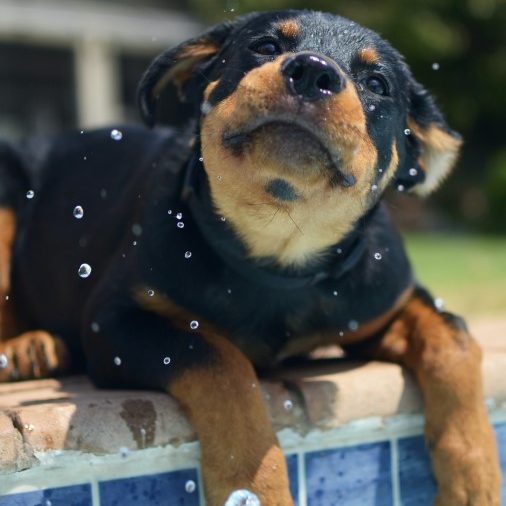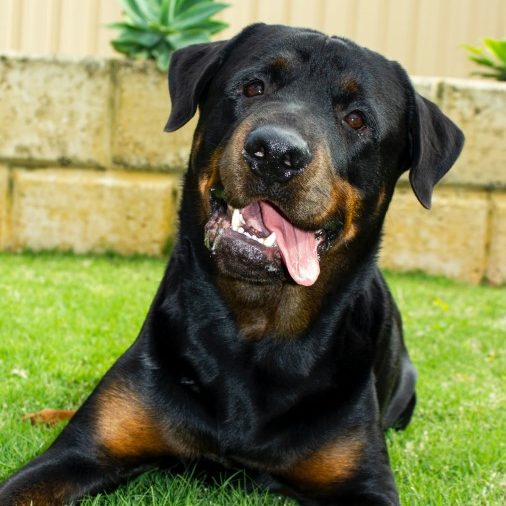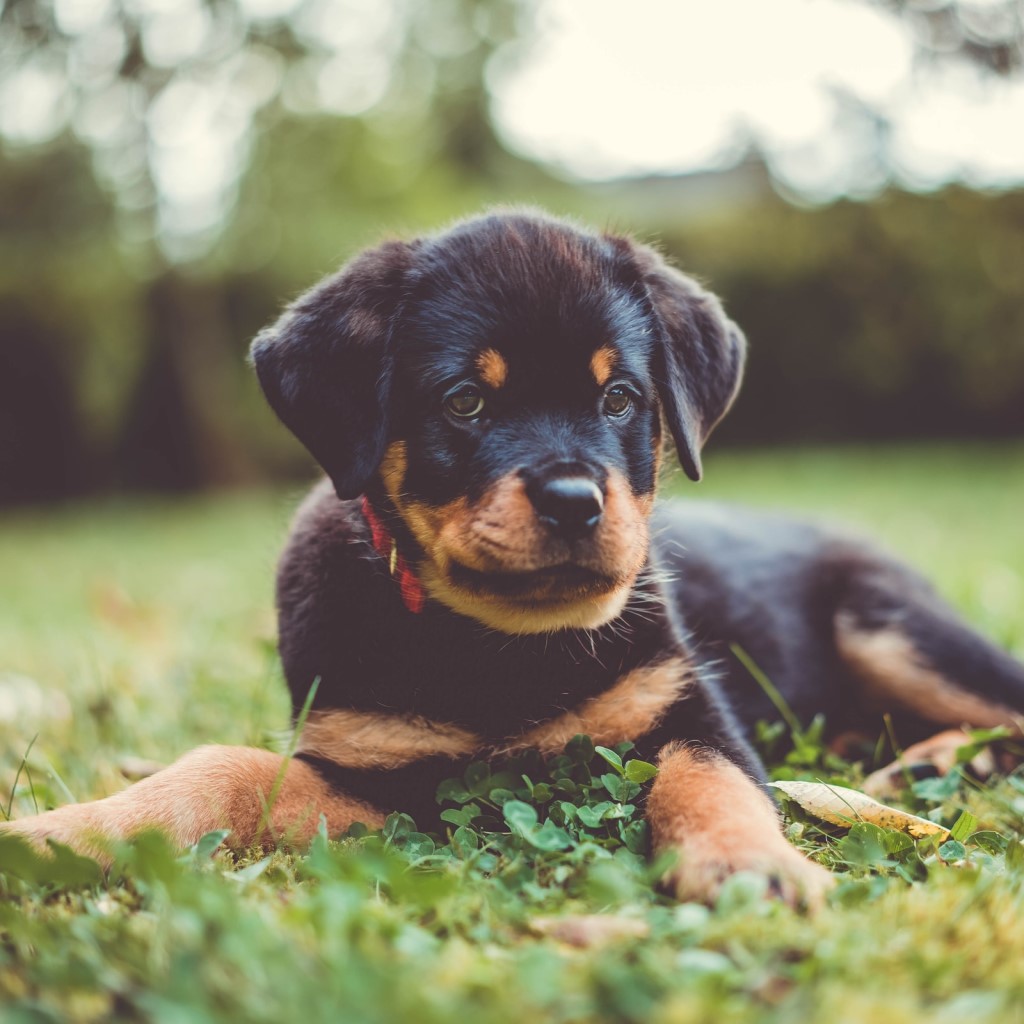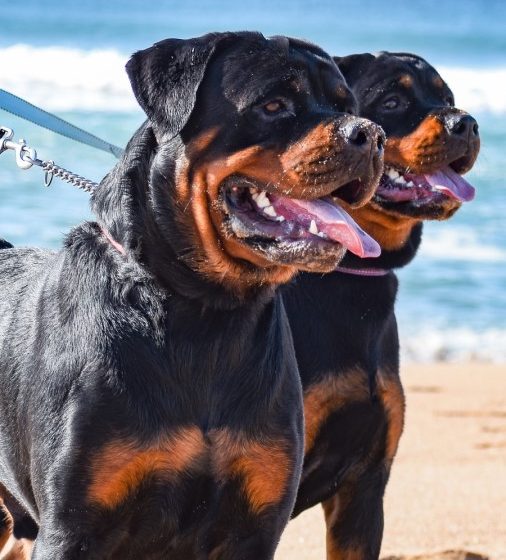Rottweiler Dog Breed Guide
Topics Covered:

 Greencross Vets
Greencross Vets
Topics Covered:
Rottweilers are a breed of working dog with origins dating as far back as the Roman Empire. Rottweilers are believed to be descendent from cattle-driving dogs left by the Roman legions in Rottweil, Germany – indicating how they got their name.
The breed then developed in Germany and throughout history has served as a guard dog, butcher’s dog, draft dog, rescue dog, and more recently as police dogs. Rottweilers were also among some of the first guide dogs for the blind and have also distinguished themselves as capable search-and-rescue workers. Their comprehensive history demonstrates the breeds ability to perform various heavy-duty tasks.
Despite the many changes in their role in society, the breed has actually not changed much in form or temperament since its first German breed standard in 1901.

Rottweilers were bred for guarding and protection work, which influenced the development of their temperament. They require experienced owners due to their size, strength, and intensity and need for proper socialisation to become a good family companion. Well-socialised Rottweilers are able to easily get along with people and other dogs.
Rottweilers are generally known to be active, intelligent, and confident. This confidence can express itself as independence if they are not provided guidance and training.
As working dogs, they are best suited to having a purpose, including training, jobs, or even protection through companionship. They are intelligent and are reasonably easy to train. Most dogs are food motivated with large appetites, so small treats can be used as incentives during training.

Newborn Rottweiler puppies are generally 500 grams, but this can vary greatly depending on the litter. From this, male Rottweilers will grow to 60-69 centimetres at the shoulder and weigh between 43 and 59 kilograms.
Females will grow to 56-64 centimetres and weigh between 39 and 52 kilograms. They are however slow maturing, meaning they may not reach this full adult size until they are 2-3 years of age.
Rottweilers can be more prone to particular health problems and disorders than some other breeds, so it is important to take them to the vet for regular health check-ups. Some of the most common issues for this breed include but are not limited to:
Hip dysplasia: This occurs when the thighbone doesn’t fit correctly into the hip joint, which can result in arthritis. Symptoms include pain in the hip, difficulty rising, unstable hip joints or limping when walking.
Elbow Dysplasia: a malformation of the elbow. Symptoms include difficulty rising and limping.
Osteochondrosis Dissecans (OCD): a disease affecting the bone cartilage of growing dogs causing arthritic-like symptoms. Symptoms include difficulty rising and limping.
Gastric Torsion Volvulus (GDV ): This occurs when the stomach is full of food and gas, and flips over inside the abdomen. This is more common among deep chested breeds of dog that have eaten a large meal and exercised afterwards. Symptoms include unproductive retching, saliva vomiting, discomfort, arched back, swollen abdomen, and restlessness.
Von Willebrand Disease: this disease is hereditary and affects the blood’s ability to clot properly causing prolonged and significant bleeding after any physical trauma.
Eye disorders: Entropian and Ectropion are eyelid defections, meaning the eyelids either roll inward or outward respectively. This is often painful and requires surgical correction. Other eye conditions common among Rottweilers include Progressive Retinal Atrophy and Cataracts.
Bone Cancer (Osteosarcoma): Bone tumours are typically found in older dogs. Symptoms include lameness, bony swellings on the limbs or lethargy.
Due to their nature and history, Rottweilers require a large space to run around and exercise, meaning they are not suited to living in an apartment. They will prove to be destructive if cooped up in a confined space.
Rottweilers require more attention than many other dog breeds, needing plenty of exercise and mental stimulation. It is recommended they get at least one hour of exercise per day. As they are companion dogs, they also require plenty of affection and like to touch their owners and follow them around.
When required however, Rottweilers can be left alone for up to 6 hours – though being left alone for too long promotes loneliness, boredom, and stress in your dog. If they are going to be left by themselves it is important to provide them with a large yard to run around in and plenty of mental stimulation to keep them occupied.

When you feed your dog a healthy diet they have more energy, less health problems, and will be less likely to develop obesity.
While they are still a puppy it is advisable to feed them life-stage appropriate food as puppies require a diet higher in calcium.
It is always recommended that you make an appointment with a veterinarian to discuss an appropriate well-balanced diet for your pet.
Use the Petbarn Food Finder to help find the best nutrition choice for your pet. Explore the available options and discuss the best nutriotional choices for your pup with your local Greencross Vets.

Rottweilers have a smooth dark colouring that gives them their beautiful appearance. There are three recognised Rottweiler colours: black and mahogany, black and tan, and black and rust. Their coat has a “saddle” pattern defined by having a lighter colouring on their stomach, legs, paws, and face. They also have a short double coat that is straight and course.
During the change of seasons Rottweilers will shed their coats from the previous season to grow out a new one. When this occurs, the coat may be thinner and appear to differ in colour since the base coat is more visible.
With their dense coat, Rottweilers require regular bathing (every four to eight weeks depending on lifestyle) to minimise shedding and to maintain healthy skin and coat. Compared to other dog breeds grooming with Rottweilers tends to be minimal.
When properly socialised, most Rottweilers are good with other pets within their own family. They can however be intolerant of same sex dogs and also show aggression towards strange dogs or people.
Rottweilers typically show affection towards and like kids they are raised with. This relationship still requires supervision since they are so big and heavy, they can accidentally knock children over when trying to show affection. Children should always be supervised whenever they are with a dog.
As a fairly large dog Rottweilers have a shorter lifespan of about 8 to 10 years.
Rottweilers originated in Germany, where they were used by butchers to drive cattle to market.
Rottweilers generally sleep for long periods of time, anywhere from 13 to 18 hours a day on average.
Rottweilers range in height from 56 centimetres for a small female up to 68 centimetres for a large male while weighing anything from 36 to 54+ kilograms.
Rottweilers have very wilful personalities but are also intelligent and enjoy learning which means they can make highly obedient dogs when trained correctly and with consistency.
Rottweilers are loyal pets that with the right training and socialisation make great companions. Rottweilers tend to form very strong bonds with their family, including children and can also grow protective of them.
Rottweilers are not always recommended for first-time owners due to their large size and strength requiring them to be trained well. However, with the proper research and training Rottweilers can still be suitable for first-time pet owners.
At Greencross Vets, nothing is more important than the health and wellbeing of your four-legged friend. If you have any more questions, please reach out to your local Greencross Vets. You can find your local Greencross Vets here. We are more than happy to help!
Or if you’re looking to adopt, find your new best friend with Petbarn adoptions.